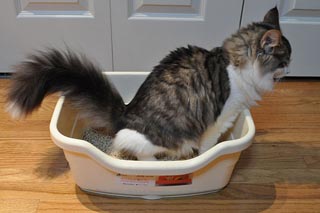cat in litter box Wikimedia

You fell in love with that expensive, hand-knotted silk rug and just had to have it for your bedroom. Unfortunately, it turns out that Fluffy loves that rug too… for entirely different (and decidedly more malodorous) reasons.
Cats will urinate and defecate in places they find attractive for potty purposes and those places are not always considered acceptable by the cat’s owner.
When this particular problem arises, I’ve found that clients often wait weeks to months (or longer!) before seeking veterinary care, then are surprised to find that there is no overnight solution, and that a resolution of the problem takes time and patience but it can be accomplished!
When dealing with a case of a cat that is eliminating in unacceptable places the first step is to get an accurate diagnosis so you and your veterinarian can start to consider any possible treatment options. A good history is essential to helping your veterinarian to understand why the cat prefers particular places for toileting.
If a picture is worth a thousand words, a video of your cat exhibiting the problem behavior or even just going about her normal routine is priceless to your veterinarian! Because owners often misinterpret their cat’s behavior, showing your veterinarian a video can be a great way to provide a more accurate example.
If your expensive rug or favorite shoes suddenly become Fluffy’s favorite toilet spot, consider these questions and share your answers with your veterinarian:
WHO does the cat live with (including other animals and people)? Who visits (again, both animals and people)? Who does the cat like and who causes a stressful reaction?
WHERE does the problem behaviour occur? Is the cat marking territory (usually occurs on vertical surfaces such as along walls)? Are there certain places it never occurs? Where are the litter trays positioned?
HOW often are the litter trays cleaned and with what? How often are trays replaced? Have you recently changed litter types/brands?
WHEN did the problem start? Have there been any other environmental changes that coincide with the onset of the problem?
WHY?
Oh, if only they could talk! :-)
One of the first things I look for is any health issues that might contribute to pain, or any neurological problems that may be impacting on the cat’s ability to use a litter tray appropriately.
After a thorough physical and neurologic exam, if a medical cause is suspected, the next step would be to conduct urine, fecal, and blood tests to further define the nature of the problem. if a painful orthopedic problem is suspected x-rays may be taken.
Common medical conditions associated with elimination problems include:
Sometimes, identifying and treating medical issues that have contributed to soiling problems may not be sufficient to change the cat's behavior. For instance, if the cat has had painful episodes of constipation when squatting in the tray, then the litter tray may remain a less favoured place to toilet because the cat has learned that the tray is associated with discomfort, even though the constipation may have been resolved.
If there doesn’t appear to be any medical reason for the problem, I turn my attention to environmental factors, which can include:
- The type and location of the litter tray
- Type of litter (and whether the type/brand of litter has recently changed)
- The cat’s relationship with other pets and human family members
- Recent changes or stressful events within the household (new baby, new pet, moving, etc.)
- How often the litter tray is scooped and/or thoroughly cleaned
- What products are used to clean the litter tray (using scented/perfumed cleaners can cause a cat to avoid using the tray).
The internet is full of cartoons and memes of cats being jerks, and some would argue their reputation for being aloof is well deserved. Many owners come to me with the preconceived notion that Fluffy is pooping in their shoes out of pure spite, however, more often than not there is a real (and fixable) issue at the heart of this behavior.
In my experience location of the litter tray and the type of litter are the most common reason a cat will avoid the litter tray. This can apply to both urinating and defecating outside the litter box as cats can have different preferences or aversions for each. Interestingly, some cats will use a litter tray to urinate but not to defecate or vice versa. Providing a litter tray in several locations is also important, especially if there are several cats in the household and there is conflict between the cats.
It can be difficult for many owners to assess whether their cat is stressed or not and tension between cats in the same household is often overlooked. Something as simple as staring can be a major threat from one cat to another.
Sometimes tensions arise between long-term cohabitants, but more often it happens when there is a new pet in the house. Sometimes, if you are not actually seeing physical fighting it can be difficult to recognize that there are issues between pets. Also, we often don’t realize that an indoor cat may be stressed by a cat outdoors, even if no physical contact can be made.
Cats are very good at communicating with their owners, however, owners are not necessarily very good at understanding what the cat is “saying."
This is why doing the detective work is important and “listening” to the cat is important. The more information you have about the where, when, what, and how, the more likely you are to find out why. And more importantly, be able to do something about it!